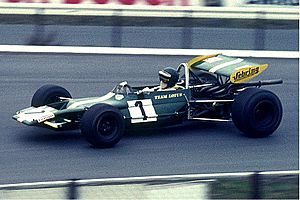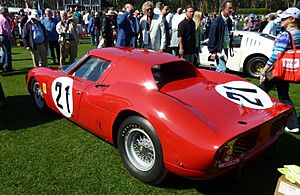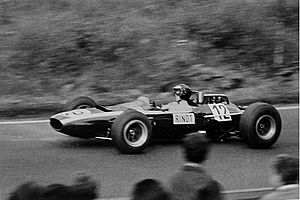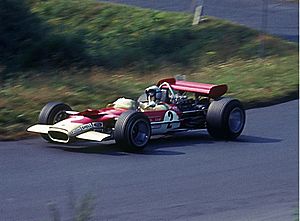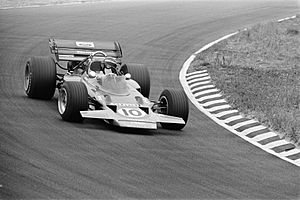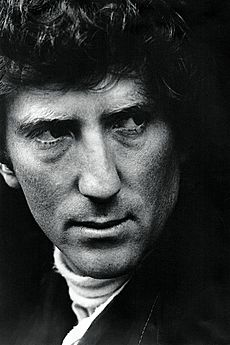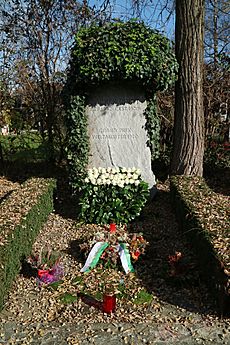Jochen Rindt facts for kids

Rindt at the 1970 Dutch Grand Prix
|
|||||||||||
| Born | Karl Jochen Rindt 18 April 1942 Mainz, Volksstaat Hessen, German Reich |
||||||||||
|---|---|---|---|---|---|---|---|---|---|---|---|
| Died | 5 September 1970 (aged 28) Autodromo Nazionale Monza, Lombardy, Italy |
||||||||||
| Formula One World Championship career | |||||||||||
| Nationality | |||||||||||
| Active years | 1964–1970 | ||||||||||
| Teams | Rob Walker (Privateer Brabham), Cooper, Brabham, Lotus |
||||||||||
| Entries | 62 (60 starts) | ||||||||||
| Championships | 1 (1970) | ||||||||||
| Wins | 6 | ||||||||||
| Podiums | 13 | ||||||||||
| Career points | 107 (109) | ||||||||||
| Pole positions | 10 | ||||||||||
| Fastest laps | 3 | ||||||||||
| First entry | 1964 Austrian Grand Prix | ||||||||||
| First win | 1969 United States Grand Prix | ||||||||||
| Last win | 1970 German Grand Prix | ||||||||||
| Last entry | 1970 Italian Grand Prix | ||||||||||
|
|||||||||||
Jochen Rindt (born 18 April 1942 – died 5 September 1970) was a famous racing driver. He was born in Germany but raced with an Austrian license. In 1970, he sadly died during practice for the 1970 Italian Grand Prix. He is the only driver ever to win the Formula One World Drivers' Championship after his death.
Rindt started racing cars in 1961. By 1963, he was racing in special open-wheel cars and doing very well in Formula Junior and Formula Two. He made his Formula One debut in 1964 at the 1964 Austrian Grand Prix. He then joined the Cooper team in 1965. After some mixed results, he moved to Brabham in 1968 and then to Lotus in 1969.
At Lotus, Rindt finally found a very fast car. However, he was often worried about how safe the Lotus cars were, as they were known for breaking down. He won his first Formula One race at the 1969 United States Grand Prix. The 1970 season was very successful for him. He mainly raced the new Lotus 72 car and won five of the first nine races.
During practice for the Italian Grand Prix at Monza, his car's brake shaft broke. Rindt's car crashed into the guardrails. He was pronounced dead on the way to the hospital. Because his closest rival, Jacky Ickx, could not score enough points in the last races, Rindt was named the World Champion after his death. Jochen Rindt left behind his wife, Nina, and their daughter, Natasha.
Overall, he competed in 62 Grand Prix races. He won six of them and finished on the podium (top three) 13 times. He was also very good at sports car racing. He won the famous 1965 24 Hours of Le Mans race with his teammate Masten Gregory in a Ferrari 250LM.
Rindt was very popular in Austria. His success made many more people interested in motorsport and Formula One. He even hosted a TV show called Motorama. He also created a successful exhibition of racing cars in Vienna. During his time in Formula One, he worked with Jackie Stewart to make racing safer.
Contents
Early Life and Family Background
Jochen Rindt was born on 18 April 1942 in Mainz, Germany. His mother was Austrian, and his father was German. His parents owned a spice business in Mainz. They sadly died during World War II when Jochen was only 15 months old. After that, his grandparents in Graz, Austria, raised him.
Even though his grandfather kept Jochen's German citizenship, Rindt always raced under an Austrian license. He once said he felt "like a European" when asked if he felt more Austrian or German. Jochen had one half-brother named Uwe.
As a child, Rindt was known for being playful and doing tricks. He broke his leg while skiing, which led to several surgeries. This made one of his legs a bit shorter than the other, causing him to limp slightly. At 16, he got a moped and started racing his friends on motocross tracks. He had some trouble in school and was even expelled a few times.
In 1960, he got his first car, an old Volkswagen Beetle. His interest in racing grew a lot after he visited the 1961 German Grand Prix with school friends, including Helmut Marko, who also became a Formula One driver.
Racing Career Highlights
Starting in Racing
Rindt's first race was in 1961, driving his grandmother's Simca Montlhéry. He was disqualified from this race for driving too aggressively. He also entered several rallies but did not do well. He became more successful when he got a special Alfa Romeo GT 1300 at a good price. With this car, he won eight races.
In 1963, Rindt moved to Formula Junior racing. He got help from Kurt Bardi-Barry, a wealthy travel agency owner and a top Austrian driver. Barry gave Rindt his one-year-old Cooper T67 car. Rindt was fastest in practice for his first race in Vallelunga. He won his second race in Cesenatico. In that race, he took the lead by driving very daringly around an accident. At this time, he was known for his bold driving style.
Success in Formula Two
Rindt was very successful in Formula Two racing, winning 29 races in total. He raced with Kurt Bardi-Barry again, driving Brabham cars. Their engines were not always the fastest. Rindt famously said, "Then I just brake two metres later," meaning he would brake later than others to make up for less power.
He first gained international attention on 18 May 1964. Rindt won the London Trophy race at the Crystal Palace circuit. He beat famous driver Graham Hill.
Like many drivers back then, Rindt raced in Formula Two while also competing in Formula One. His last F2 race was in August 1970. In 1967, he was amazing in Formula Two, winning nine races in his Brabham BT23. Because he was already an experienced Formula One driver, his F2 results did not count towards the championship. The title went to Jacky Ickx. Still, his great performances earned him the nickname "king of Formula 2."
Winning in Sports Cars
Besides single-seater racing, Rindt also raced sports car racing in the mid-1960s. He competed in the 24 Hours of Le Mans race four times. This is a very long endurance race. In his first Le Mans race in 1964, his car broke down before he even got to drive it.
Rindt's best result was the next year, at the 1965 24 Hours of Le Mans. He shared a Ferrari 250LM with American driver Masten Gregory. They won the race! Neither driver was very happy with their car at first. They thought it was not fast enough. At the start, drivers had to run to their cars. Rindt did a forward roll to get into his car quickly and take an early lead.
They had many problems early in the race. The car did not restart during Gregory's first pit stop. Later, the engine partly failed. Rindt had already changed into his normal clothes, thinking their race was over. But after 30 minutes of repairs, the car restarted. Rindt and Gregory decided to drive "flat out" (as fast as possible) for the rest of the race. Rindt drove most of the night, moving from 18th to third place by morning. Gregory convinced Rindt to let him drive the end of the race. He thought Rindt might drive too fast and break the car. Even though they drove very hard, the car survived, giving them an unexpected victory.
Later that year, Rindt won another sports car race at Zeltweg. He used a special lever to activate his brake lights early. This made the driver behind him, Mike Parkes, brake sooner, allowing Rindt to stay ahead and win.
He never finished the Le Mans race again after his 1965 victory. In 1966, his Ford GT40 had an engine failure. In 1967, his Porsche 907 broke down.
Formula One Career
Early Years with Cooper and Brabham (1964–1968)
Rindt made his Formula One debut at his home race, the 1964 Austrian Grand Prix. He drove a Brabham BT11 car. He had to stop the race after 58 laps because of a broken steering column. This was his only Grand Prix that season.
For the 1965 Formula One season, Rindt joined the Cooper team as a full-time driver. His teammate was Bruce McLaren. Cooper was a top team before, but they were struggling at this time. In his first race, the 1965 South African Grand Prix, his car had electrical problems, and he had to stop. His best result was fourth place at the 1965 German Grand Prix. He finished the season with four points, placing 13th.
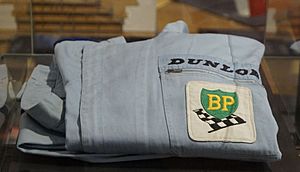
In 1966, Cooper introduced a new car, the Cooper T81. They used old Maserati V12 engines. These engines were powerful but very heavy. New rules for engines came in that year, doubling the size. Many teams had trouble with the new rules. This made Cooper competitive even with their older engines. Rindt became the team leader after McLaren left. He was later joined by 1964 world champion John Surtees.
At the second race of the year, the 1966 Belgian Grand Prix, Rindt qualified second. In a race with heavy rain, he took the lead on lap four. He spun several times on the wet track but stayed in the lead until lap 21. Surtees then passed him and won. This was Rindt's first Formula One podium finish (top three). He achieved three podium finishes that year, ending the season in third place in the championship.
The 1967 season was not as good. Rindt only finished two races, both in fourth place. He ended the season in 13th place with six points.
Before 1968, Rindt received offers from almost every team. He moved to Brabham, who had been world champions for the past two seasons. But technical problems limited him that year. Brabham's engine was not as good as the new Cosworth DFV engine that many other teams used. Rindt finished only two races, both in third place.
His first podium was in South Africa. He finished third, close behind Graham Hill. The race was won by Jim Clark, a close friend of Rindt's. This was Clark's last Formula One race, as he died three months later in a Formula Two race. Rindt was very sad about Clark's death. He told a journalist, "If Jim Clark is not safe, what can happen to us?" His second podium was in heavy rain and fog at the 1968 German Grand Prix. He finished just four seconds behind Graham Hill after a close fight. His eight points placed him 12th in the championship.
During these years, he also raced in the Indianapolis 500 in 1967 and 1968. He did not finish well in either race. In 2014, Heinz Prüller remembered Rindt saying about Indianapolis in 1967: "In Indianapolis, I always feel like I am on my way to my own funeral." He also said about the track: "It is terrible, I only drive there because of the money."
Joining Team Lotus (1969–1970)
The 1969 Season
For the 1969 Formula One season, Rindt joined Lotus, the team that had won the Constructors' Championship in 1968. He joined the defending Drivers' Champion, Graham Hill. Rindt felt uneasy about joining Lotus. This was because Lotus cars were known for being unreliable and often breaking down. Between 1967 and 1969, the team was involved in 31 accidents. Hill himself had nine crashes with Lotus cars.
When Rindt joined Lotus, his friend and manager Bernie Ecclestone said they knew Brabham might have been a safer choice. But the speed of the Lotus car gave Rindt a chance to win the championship. Rindt famously said: "At Lotus, I can either be world champion or die." Because he was so unsure, Rindt did not sign his contract until just before the 1969 Spanish Grand Prix.
Rindt's worries seemed right when both he and Hill had high-speed crashes at the Spanish Grand Prix. The wings on their cars broke off, causing accidents that could have been fatal. Rindt's car flew off the track and crashed into the barriers. He only broke his nose, but a race official lost an eye. Rindt was very angry with Lotus's owner, Colin Chapman, about the failure. He told a reporter: "I blame him [Chapman] because he should have known the wing would break." He also said that these wings were "insanity" and should not be allowed. He added that it was "impossible" to get any sense into Colin Chapman's head. When asked if he trusted Lotus, he replied: "I never had any trust in Lotus." He described his relationship with the team as "purely business." His accident kept him out of the 1969 Monaco Grand Prix, which Hill won.
Jackie Stewart later said that Rindt's 1969 season was when he "came of age." At the end of the year, he was called "The only driver to challenge Stewart seriously." He finished fourth in the championship. The poor reliability of the Lotus 49B car affected him. He had to stop in seven races. At the 1969 British Grand Prix, Rindt fought a close battle with Stewart for the lead. Rindt finished fourth after having to pit because a part of his car was rubbing on the tire.
At the 1969 Italian Grand Prix, he was part of a memorable finish. He started from pole position and traded the lead with Stewart and Piers Courage many times. On the last lap, Rindt, Stewart, McLaren, and Jean-Pierre Beltoise were all very close. Stewart won by only eight hundredths of a second ahead of Rindt. It was the closest 1-2-3-4 finish in the sport's history. Rindt won his first Grand Prix at the second-to-last race of the season, the 1969 United States Grand Prix. He won $50,000, which was the biggest prize in Formula One at the time. His victory was overshadowed by a serious accident involving his teammate Hill, who crashed and suffered major leg injuries.
The 1970 Season
For 1970, Rindt's teammate at Lotus was John Miles. Graham Hill had left the team. Rindt became the clear team leader. At the first race in South Africa, he qualified fourth but had to stop with an engine problem. At the next race, the 1970 Spanish Grand Prix, Lotus introduced their new, revolutionary car design. The Lotus 72 had two radiators, one on each side of the cockpit. It also had new suspension and brakes. During its first practice, a part of the car broke, sending Rindt into a spin. The car was not effective in the race, and Rindt retired after nine laps.
Since the Lotus 72 was not working as hoped, it was sent back to the factory for changes. Rindt used the old Lotus 49 for the next race in Monaco. The tires for the new car made the older car unstable. But Rindt drove what his race engineer called "the race of his life." He started eighth and moved through the field on a track known for being hard to overtake on. In the final stages, he was second, catching up to leader Jack Brabham. On the very last corner of the last lap, Brabham braked too late and crashed. This allowed Rindt to take his first victory of the season. Rindt used the Lotus 49 one last time at the 1970 Belgian Grand Prix. He criticized the organizers for having large gaps in the guardrails. He qualified on the front row but retired with another engine problem.
At the 1970 Dutch Grand Prix, Rindt finally used the improved Lotus 72. He set the fastest qualifying time. Rindt went on to win his first race in the Lotus 72. But it was not a happy win for him. On lap 23, his close friend Piers Courage died in a fiery crash. Rindt was very shaken by losing another fellow driver and thought about retiring from racing.
After his success at Zandvoort, Rindt felt more confident in the new Lotus 72. He called it "the best racing car that exists at the moment." But he still had problems. During practice for the 1970 French Grand Prix, Rindt chose to use his old open-front helmet instead of a new, hot one. A stone from another car hit him in the face, causing a deep cut. He also had a steering failure on his car. Very upset about another mechanical problem, he went to the Lotus garage and was very angry with Colin Chapman. Rindt still won the race, taking the lead in the championship.
The next race was the 1970 British Grand Prix at Brands Hatch. Jacky Ickx led early, but when his car broke down, Rindt passed Brabham for the lead. Brabham then took the lead back on lap 69. It looked like Brabham would win, but on the last lap, he ran out of fuel. This allowed Rindt to take his third win in a row. His victory was questioned because his car's rear wing was not at the correct height. Rindt was first disqualified but was later put back as the winner after three hours of discussion.
The 1970 German Grand Prix was moved to Hockenheim for safety reasons. Rindt took his fourth victory in a row there. This race was another close fight between Rindt and Ickx. This meant Rindt could have won the championship at his home race, the 1970 Austrian Grand Prix. He started from pole position, but his engine failed, and he had to stop. The championship decision was then moved to the next race in Monza.
Death and Lasting Legacy
The next race was the 1970 Italian Grand Prix at Monza. This track was known for very high speeds. Many teams, including Lotus, decided to remove the rear wings from their cars to go even faster. This reduced drag.
On the day of the practice session, Rindt was using higher gears to take advantage of the reduced drag. This increased his car's top speed to about 205 miles per hour. On his fifth lap, he crashed heavily as he approached the Parabolica corner.
Later investigations found that the accident started because of a failure in the car's right front brake shaft. However, Rindt's death was caused by crash barriers that were not installed correctly.
Rindt was pronounced dead on the way to the hospital in Milan. Lotus withdrew all their cars from the race. The Grand Prix went ahead, and Clay Regazzoni won, but the celebrations were quiet. There was a long investigation into Rindt's death in Italy. Lotus team owner Colin Chapman was put on trial but was cleared of all charges in 1976. The destroyed Lotus 72 car remained in Italy and was later found and traded.
Rindt was buried in Graz, Austria, on 11 September 1970.
When he died, Rindt had won five of the ten Grand Prix races that year. This gave him a big lead in the Drivers' Championship. After winning the next race in Canada, Jacky Ickx was 17 points behind Rindt. This meant Ickx could still win the title if he won the last two races. But at the 1970 United States Grand Prix, Ickx only finished fourth. This made Jochen Rindt motor racing's only posthumous (after death) world champion. His championship trophy was given to his widow, Nina, by Jackie Stewart in Paris on 18 November 1970.
Jochen Rindt has been remembered in many ways. A Formula Two race was renamed the Jochen Rindt Memorial Trophy. In 2000, on the 30th anniversary of his death, the city of Graz unveiled a bronze plaque in his memory. His wife Nina and daughter Natasha were there. A corner at the Red Bull Ring in Austria is named after Rindt.
The Historic Sports Car Club in the United Kingdom has a historic Formula 2 championship. Its pre-1972 category is called the "Class A Jochen Rindt Trophy."
Personal Life and Impact
In March 1967, Rindt married Nina Lincoln. She was a Finnish model and the daughter of racing driver Curt Lincoln. Nina had broken up with Rindt once and sent back her engagement ring. But Rindt sent it back with a note telling her to keep it until she changed her mind. She did, saying, "I like men who know what they want." The couple moved to Switzerland and built a house together. The Rindts had one daughter, Natasha, who was two years old when her father died. She later worked with Bernie Ecclestone.
Rindt met Bernie Ecclestone when he was at Cooper. They became good friends. Rindt saw Ecclestone's business talent and let him manage his racing contracts. Ecclestone said, "I was never his manager, we were good friends. I helped him with any help he ever needed." After Rindt's accident, it was Ecclestone who carried his helmet back to the pit lane.
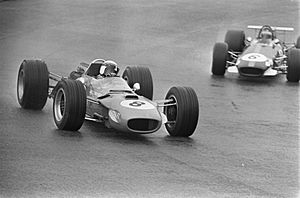
In Formula One, Rindt had several friends among other drivers, especially Jackie Stewart. They met in 1964 and became close friends. They often went on holidays together and lived near each other in Switzerland. Sometimes, Jim Clark would join them. Rindt became involved in Stewart's efforts to make Formula One safer. He was one of the main figures in the Grand Prix Drivers' Association (GPDA). For his role in the safety campaign, some people criticized Rindt. Reporters sometimes called Stewart, Rindt, and Joakim Bonnier the "Geneva connection" because they lived in Switzerland. Stewart said that Rindt took some time to understand how serious the safety issues were, but then he was a "good ally." After Rindt's death, his wife Nina remained close with the Stewarts.
Rindt's success made motorsport very popular in Austria. Helmut Zwickl called him "the driving instructor of the nation." In 1965, Rindt organized the first exhibition of racing cars in Austria, called the Jochen-Rindt-Show in Vienna. It was an instant hit, with 30,000 visitors on the first weekend. He used his connections to bring in famous people like Joakim Bonnier and former Mercedes manager Alfred Neubauer. Other drivers, like Jackie Stewart, also attended. The show became an annual event. It later moved to Essen, Germany, in 1970, shortly after Rindt's death. It is still held there today as the Essen Motor Show.
Rindt, with help from Ecclestone, was very good at promoting himself. He got good sponsorship and advertising deals. After he became famous in racing, two race tracks were built in Austria: the Österreichring (now Red Bull Ring), where Rindt worked as a consultant, and the Salzburgring. Rindt's popularity grew even more through his TV show Motorama. This monthly show gave tips for driving on public roads, reported on Grand Prix races, and featured interviews with other drivers.
Racing Record
Career Summary
| Season | Series | Team | Races | Wins | Poles | F/laps | Podiums | Points | Position |
|---|---|---|---|---|---|---|---|---|---|
| 1964 | Formula One | Rob Walker Racing Team | 1 | 0 | 0 | 0 | 0 | 0 | NC |
| 24 Hours of Le Mans | North American Racing Team | 1 | 0 | 0 | 0 | 0 | N/A | DNF | |
| 1965 | Formula One | Cooper | 9 | 0 | 0 | 0 | 0 | 4 | 13th |
| Trophées de France | Roy Winkelmann Racing | 4 | 1 | 1 | 1 | 3 | 16 | 2nd | |
| 24 Hours of Le Mans | North American Racing Team | 1 | 0 | 0 | 0 | 1 | N/A | 1st | |
| 1966 | Formula One | Cooper | 9 | 0 | 0 | 0 | 3 | 22 | 3rd |
| 24 Hours of Le Mans | F.R. English Ltd. \ Comstock Racing | 1 | 0 | 0 | 0 | 0 | N/A | DNF | |
| 1967 | Formula One | Cooper | 10 | 0 | 0 | 0 | 0 | 6 | 13th |
| Trophées de France | Roy Winkelmann Racing | 4 | 3 | 1 | 1 | 4 | 33 | 1st | |
| RAC British F2 Championship | Roy Winkelmann Racing | 5 | 3 | 0 | 0 | 0 | 27 | 1st | |
| 24 Hours of Le Mans | Porsche System Engineering | 1 | 0 | 0 | 0 | 0 | N/A | DNF | |
| USAC Championship Car | Wagner Lockheed Brake Fluid | 1 | 0 | 0 | 0 | 0 | 0 | NC | |
| 1968 | Formula One | Brabham Racing Organisation | 12 | 0 | 2 | 0 | 2 | 8 | 12th |
| USAC Championship Car | Repco-Brabham | 1 | 0 | 0 | 0 | 0 | 0 | NC | |
| 1969 | Formula One | Gold Leaf Team Lotus | 10 | 1 | 5 | 2 | 3 | 22 | 4th |
| Tasman Series | 7 | 2 | 0 | 0 | 4 | 30 | 2nd | ||
| 1970 | Formula One | Gold Leaf Team Lotus | 9 | 5 | 3 | 1 | 5 | 45 | 1st |
|
|
|||||||||
Complete Formula One World Championship Results
(key) (Races in bold indicate pole position; races in italics indicate fastest lap)
| Year | Entrant | Chassis | Engine | 1 | 2 | 3 | 4 | 5 | 6 | 7 | 8 | 9 | 10 | 11 | 12 | 13 | WDC | Pts |
|---|---|---|---|---|---|---|---|---|---|---|---|---|---|---|---|---|---|---|
| 1964 | Rob Walker Racing Team | Brabham BT11 | BRM P56 1.5 V8 | MON | NED | BEL | FRA | GBR | GER | AUT Ret |
ITA | USA | MEX | NC | 0 | |||
| 1965 | Cooper | Cooper T73 | Climax FWMV 1.5 V8 | RSA Ret |
ITA 8 |
13th | 4 | |||||||||||
| Cooper T77 | MON DNQ |
BEL 11 |
FRA Ret |
GBR 14 |
NED Ret |
GER 4 |
USA 6 |
MEX Ret |
||||||||||
| 1966 | Cooper | Cooper T81 | Maserati 9/F1 3.0 V12 | MON Ret |
BEL 2 |
FRA 4 |
GBR 5 |
NED Ret |
GER 3 |
ITA 4 |
USA 2 |
MEX Ret |
3rd | 22 (24) | ||||
| 1967 | Cooper | Cooper T81 | Maserati 9/F1 3.0 V12 | RSA Ret |
MON Ret |
CAN Ret |
13th | 6 | ||||||||||
| Cooper T81B | NED Ret |
|||||||||||||||||
| Maserati 10/F1 3.0 V12 | BEL 4 |
FRA Ret |
USA Ret |
MEX | ||||||||||||||
| Cooper T86 | GBR Ret |
GER Ret |
ITA 4 |
|||||||||||||||
| 1968 | Brabham Racing Organisation | Brabham BT24 | Repco 740 3.0 V8 | RSA 3 |
ESP Ret |
MON Ret |
12th | 8 | ||||||||||
| Brabham BT26 | Repco 860 3.0 V8 | BEL Ret |
NED Ret |
FRA Ret |
GBR Ret |
GER 3 |
ITA Ret |
CAN Ret |
USA Ret |
MEX Ret |
||||||||
| 1969 | Gold Leaf Team Lotus | Lotus 49B | Ford Cosworth DFV 3.0 V8 | RSA Ret |
ESP Ret |
MON | NED Ret |
FRA Ret |
GBR 4 |
GER Ret |
ITA 2 |
CAN 3 |
USA 1 |
MEX Ret |
4th | 22 | ||
| 1970 | Gold Leaf Team Lotus | Lotus 49C | Ford Cosworth DFV 3.0 V8 | RSA 13 |
MON 1 |
BEL Ret |
1st | 45 | ||||||||||
| Lotus 72 | ESP Ret |
|||||||||||||||||
| Lotus 72C | NED 1 |
FRA 1 |
GBR 1 |
GER 1 |
AUT Ret |
ITA DNS |
CAN | USA | MEX | |||||||||
|
|
||||||||||||||||||
Non-Championship Formula One Results
(key) (Races in bold indicate pole position) (Races in italics indicate fastest lap)
| Year | Entrant | Chassis | Engine | 1 | 2 | 3 | 4 | 5 | 6 | 7 | 8 | 9 | 10 | 11 | 12 | 13 | 14 | |
|---|---|---|---|---|---|---|---|---|---|---|---|---|---|---|---|---|---|---|
| 1963 | Jochen Rindt | Cooper T67 | Ford 109E 1.5 L4 | LOM | GLV | PAU | IMO | SYR | AIN | INT | ROM | SOL | KAN | MED | AUT Ret |
OUL | RAN |
|
| 1965 | Cooper | Cooper T77 | Climax FWMV 1.5 V8 | ROC 7 |
SYR | SMT DSQ |
INT Ret |
|||||||||||
| Roy Winkelmann Racing | Brabham BT16 (F2) | Ford Cosworth FVA 1.6 L4 | MED Ret |
RAN | ||||||||||||||
| 1966 | Cooper | Cooper T81 | Maserati 9/F1 3.0 V12 | RSA | SYR | INT 5 |
OUL | |||||||||||
| 1967 | Cooper | Cooper T81 | Maserati 9/F1 3.0 V12 | ROC Ret |
SPR | INT | SYR | |||||||||||
| Roy Winkelmann Racing | Brabham BT23 (F2) | Ford Cosworth FVA 1.6 L4 | OUL 6 |
ESP | ||||||||||||||
| 1968 | Brabham Racing Organisation | Brabham BT26 | Repco 860 3.0 V8 | ROC | INT | OUL Ret |
||||||||||||
| 1969 | Gold Leaf Team Lotus | Lotus 49B | Ford Cosworth DFV 3.0 V8 | ROC Ret |
INT 2 |
MAD | ||||||||||||
| Lotus 63 | OUL 2 |
|||||||||||||||||
| 1970 | Gold Leaf Team Lotus | Lotus 49C | Ford Cosworth DFV 3.0 V8 | ROC 2 |
||||||||||||||
| Lotus 72 | INT Ret |
OUL 2 |
||||||||||||||||
|
|
||||||||||||||||||
Complete 24 Hours of Le Mans Results
| Year | Team | Co-drivers | Car | Class | Laps | Pos. | Class pos. |
|---|---|---|---|---|---|---|---|
| 1964 | Ferrari 250LM | P 5.0 | 0 | DNF | DNF | ||
| 1965 | Ferrari 250LM | P 5.0 | 348 | 1st | 1st | ||
| 1966 | Ford GT40 Mk I | S 5.0 | 8 | DNF | DNF | ||
| 1967 | Porsche 907 | P 2.0 | 103 | DNF | DNF | ||
|
|
|||||||
Complete Indianapolis 500 Results
| Year | Chassis | Engine | Start | Finish |
|---|---|---|---|---|
| 1967 | Eagle | Ford | 32nd | 24th |
| 1968 | Brabham | Repco | 16th | 32nd |
|
|
||||
See also
 In Spanish: Jochen Rindt para niños
In Spanish: Jochen Rindt para niños


